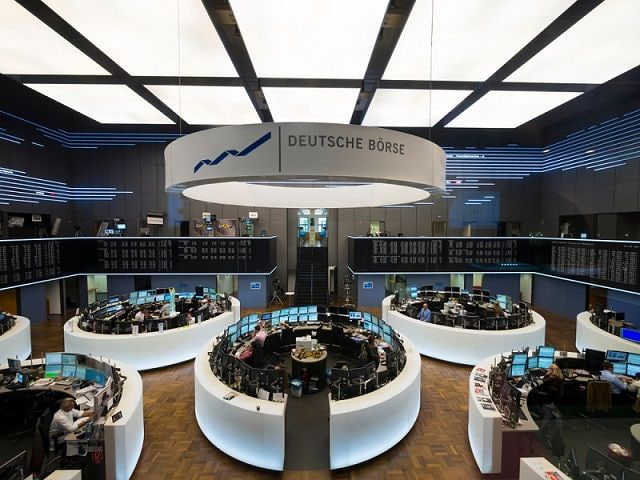Decoding the European Market: A Deep Dive into DAX, CAC40, and FTSE 100 Daily Fluctuations
Meta Description: Unraveling the intricacies of European stock market performance: a detailed analysis of the daily movements of the DAX, CAC40, and FTSE 100 indices, including expert insights and actionable takeaways. Learn about key factors influencing these major European markets and what they mean for your investment strategy.
Ever wondered what makes the European stock markets tick? One day, the DAX is soaring, the next it's slightly dipping. The CAC40 might be celebrating a robust climb, while the FTSE 100 remains stubbornly flat. It's a fascinating, often bewildering, dance of economic forces, investor sentiment, and global events. This isn't just about numbers on a screen; it's about understanding the pulse of some of the world's most influential economies. This article delves deep into the daily fluctuations of the three major European indices – the German DAX, the French CAC40, and the UK's FTSE 100 – providing a comprehensive analysis that goes beyond the headline numbers. We'll unpack the underlying factors driving market movement, offering insights that can help you navigate this complex landscape. We'll also explore the interconnectedness of these markets, examining how events in one country impact the performance of others. Forget the dry, technical jargon; this is an approachable, human-centered look at what truly shapes the European financial scene. We'll dissect recent market movements with real-world examples, offering practical advice and exploring potential future trends. So, fasten your seatbelts and prepare for a thrilling ride through the world of European stock market analysis! This isn't just another market report; it's your passport to a deeper understanding of financial markets, delivered in a clear, engaging, and insightful way. Get ready to unlock the secrets behind those daily fluctuations and empower yourself with the knowledge you need to make informed decisions.
Understanding the DAX, CAC40, and FTSE 100
These three indices represent the core of the European stock market, each reflecting the economic health and investor confidence of its respective country. Let's break down their individual characteristics:
-
DAX (Deutscher Aktienindex): The DAX is Germany's leading stock market index, mirroring the performance of 40 of the largest and most liquid companies listed on the Frankfurt Stock Exchange (FWB). It's heavily weighted towards sectors such as automobiles, chemicals, and industrial goods, making it particularly sensitive to global manufacturing trends and economic growth in Europe and beyond. Think Volkswagen, BMW, Siemens – the giants that drive Germany's industrial might. A dip in the DAX often signals concerns about the European manufacturing sector, while a surge reflects positive sentiment about German and broader European industrial output.
-
CAC 40 (Cotation Assistée en Continu): France's flagship index, the CAC 40, tracks the 40 largest French companies listed on Euronext Paris. Unlike the DAX's industrial focus, the CAC 40 features a more balanced mix of sectors, including luxury goods, energy, and financials. This makes it less vulnerable to fluctuations in specific industrial sectors, but more susceptible to broader global economic shifts. Think luxury brands like LVMH and Kering, major players in the global luxury market. The performance of the CAC 40 often reflects the overall health of the European economy and global consumer spending.
-
FTSE 100 (Financial Times Stock Exchange 100 Index): The FTSE 100 represents the 100 largest companies listed on the London Stock Exchange. It's known for its significant weighting towards internationally focused companies, many of which generate a substantial portion of their revenue outside the UK. This makes the FTSE 100 relatively less sensitive to domestic UK economic performance and more responsive to global economic trends. Oil giants, banking behemoths, and multinational corporations dominate this index. Its behavior often acts as a barometer for global investor sentiment and the health of the global economy.
Recent Market Movements: A Case Study
On December 18th, the European market showed mixed signals. While the CAC 40 saw a healthy increase of 0.26%, reaching 7384.62 points, the DAX experienced a slight decrease of 0.02%, closing at 20242.57 points. The FTSE 100, on the other hand, showed a modest gain of 0.05%, ending at 8199.11 points. This divergence highlights the importance of analyzing each index individually, considering its unique composition and sensitivity to specific economic factors. For instance, the CAC 40's rise could be attributed to positive news about the French economy or strong performance in the luxury goods sector. Conversely, the slight dip in the DAX might reflect concerns about slowing industrial growth in Germany or wider anxieties about the global economic outlook and supply chain issues. The FTSE 100's modest increase likely reflected a mix of global investor sentiment and the performance of its internationally-focused companies.
Factors Influencing Daily Fluctuations
A multitude of factors can impact the daily performance of these indices. These include:
- Geopolitical Events: Global tensions, political instability, and international conflicts significantly influence market sentiment. Worries about war, trade disputes, and sanctions can lead to substantial market volatility.
- Economic Data: Key economic indicators like inflation rates, GDP growth, unemployment figures, and consumer confidence reports directly impact market performance. Unexpectedly good or bad news can trigger sharp movements.
- Corporate Earnings: The performance of individual companies within the indices heavily influences overall market movement. Strong earnings reports usually boost investor confidence, while disappointing results can trigger sell-offs.
- Interest Rate Changes: Decisions by central banks on interest rate adjustments profoundly affect borrowing costs and investor behaviour. Rate hikes can dampen economic growth, while cuts can stimulate investment.
- Currency Fluctuations: Changes in exchange rates can affect the profitability of multinational corporations and impact the competitiveness of exports. A strong Euro, for instance, can negatively impact the export sector of Germany.
Navigating the Market: Tips and Strategies
Investing in the European market requires careful consideration and a diversified approach. Here are some key strategies:
- Diversify your portfolio: Don't put all your eggs in one basket. Spread your investments across different sectors and indices to mitigate risk.
- Long-term perspective: Focus on the long-term growth potential rather than short-term fluctuations. Market volatility is normal.
- Thorough research: Conduct in-depth research before making any investment decisions. Understand the underlying factors that drive market movements.
- Professional advice: Consider seeking financial advice from a qualified professional to help you create a personalized investment strategy.
- Stay informed: Keep yourself updated on global and European economic news and events to make informed investment choices.
Frequently Asked Questions (FAQs)
Q1: Are these indices correlated?
A1: While the indices are interconnected, their correlation isn't absolute. They react differently to specific events, reflecting the unique economic structures and sector compositions of their respective countries. However, significant global events tend to affect all three indices.
Q2: How risky is investing in these indices?
A2: Investing in any stock market involves risk. The level of risk depends on your investment strategy, the timeframe, and your risk tolerance. Diversification helps mitigate risk.
Q3: What are the best times to invest?
A3: There's no surefire "best" time. Successful investing relies on long-term planning, thorough research, and a well-diversified portfolio. Market timing is often unreliable.
Q4: How can I track these indices?
A4: You can track these indices through various financial news websites, brokerage platforms, and dedicated financial data providers. Many offer real-time data and charting tools.
Q5: What are the potential long-term growth prospects?
A5: The long-term growth prospects depend on various factors, including the overall health of the European economy, global economic conditions, and political stability. It's vital to conduct thorough research.
Q6: Should I invest based solely on daily fluctuations?
A6: Absolutely not! Daily fluctuations shouldn't be the primary driver of your investment decisions. Focus on long-term growth prospects and diversification. Short-term trading can be very risky.
Conclusion
The European stock markets, represented by the DAX, CAC40, and FTSE 100, present both opportunities and challenges for investors. Understanding the intricate interplay of economic factors, geopolitical events, and corporate performance is crucial for navigating this dynamic landscape. By adopting a long-term perspective, diversifying your portfolio, and staying informed, you can enhance your chances of success in this exciting yet complex arena. Remember, this isn't just about numbers; it's about understanding the stories behind them.



